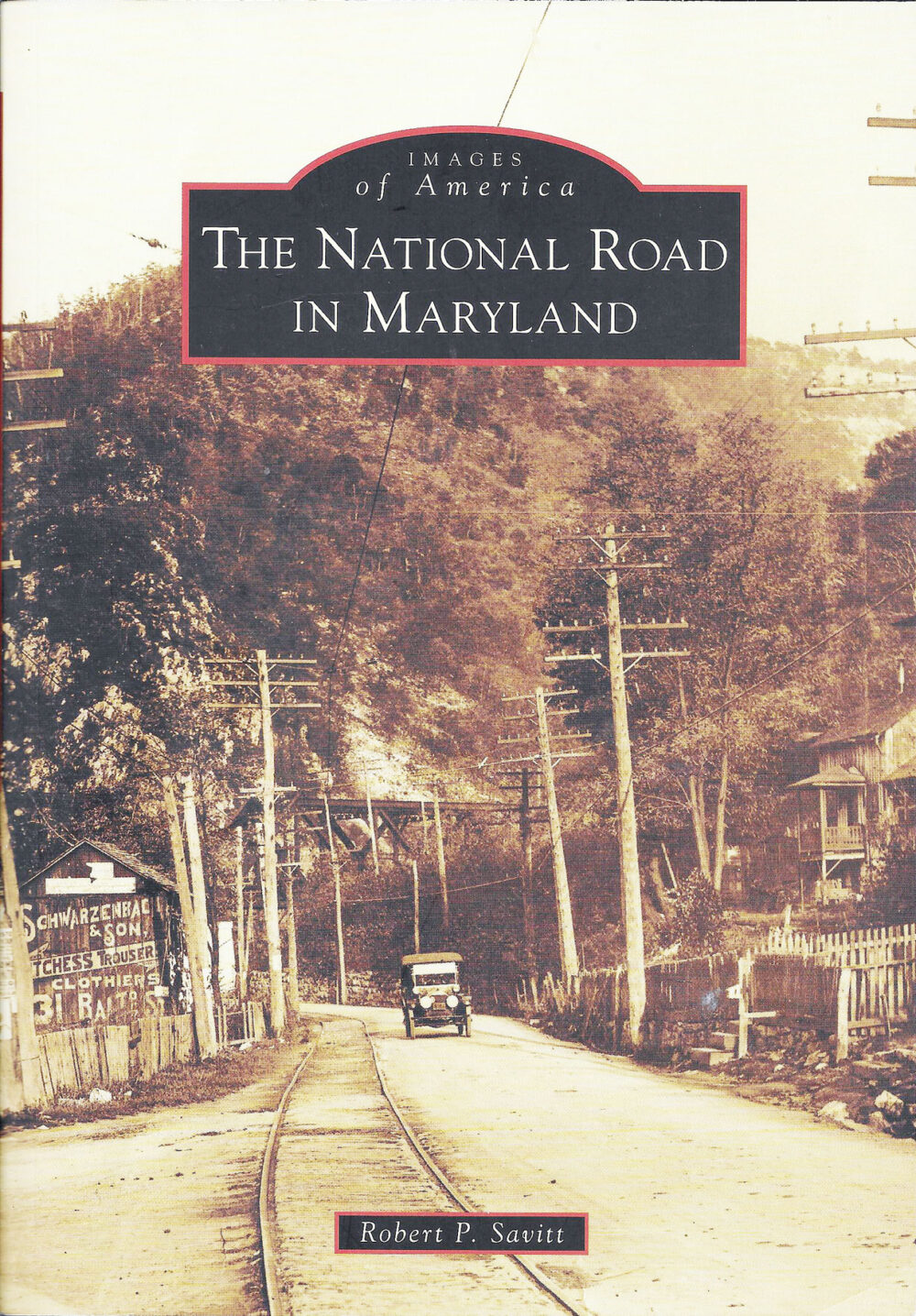Danielle Jackson
2023 FFA Butchering Day
Held February 10 at Catoctin High School
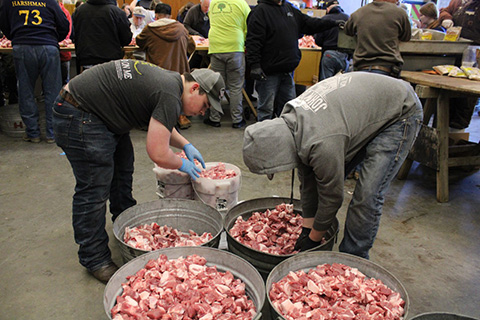
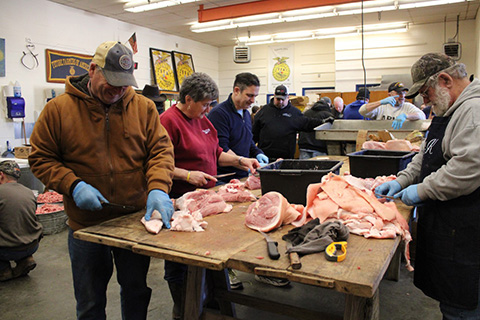
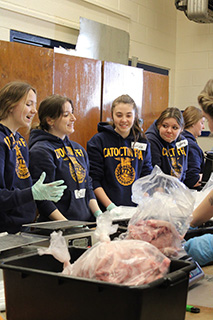
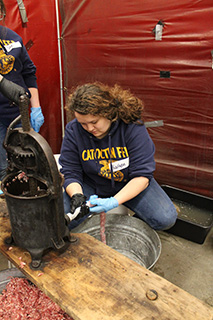
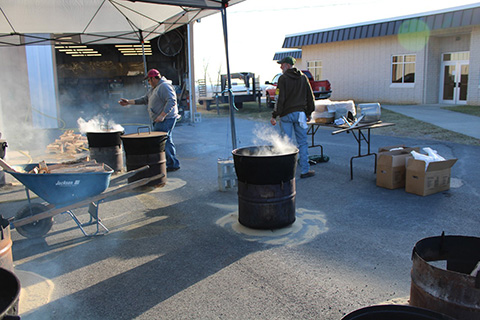
Photos by Danielle Jackson
The scent of wood burning under kettles, the sound of fire crackling, and the sharpening of knives permeated the early morning air at the annual Catoctin FFA chapter, and alumni Hog Butchering Day. The traditional event took place this year on Friday, February 10, at Catoctin High School. The FFA butchering day is something that families and community members in and around the Thurmont area know and celebrate. They use this time to further strengthen the bonds within this tight-knit community that is nestled within the Appalachian Mountains. Although the event of a family butchering is fading into something that you don’t commonly see anymore, the Catoctin High School FFA and Alumni Chapters are committed to preserving the tradition and teaching the next generation the importance of knowing where their food comes from.
This is estimated to be the 35th year that the school has held this event. Generations, young and old, come to help and participate (myself included, once as a Chapter member and now as an Alumni member). Approximately 100 Chapter, Alumni, and community members participated in this year’s butchering.
This event is held as a fundraiser for the Catoctin FFA Chapter, and the proceeds go toward the Chapter and Alumni banquet that is held in May. This year, the Chapter and Alumni processed 23 whole hogs, with an additional 340 lbs. of ribs, 850 lbs. of pork butts, 660 lbs. of boneless loins, and 560 lbs. of bone-in loins (pork chops) to fill presold meat orders. The hogs and extra meat are purchased from nearby businesses within the community. The hogs are killed, scalded, cleaned, and halved at a USDA-approved facility and then brought to the school. The Chapter, Alumni, and community members take care of the rest. Alumni and Chapter members began setting up grinders, saws, kettles, and tables the night before, and then they were back at the school before the sun rose the next day to get started.
The annual event is also an educational experience that ties in to other areas of the school curriculum as well, such as math, science, photography, social studies, and history. Throughout the day, Catoctin High School teachers, staff, students, and classes visited the butchering to observe and learn how this process is done from start to finish. Some teachers even made assignments for their classes about the butchering. This also lets students see all of the hard work that goes into a butchering and how food is put on their own tables. And it also gives other students at the school a new and better appreciation for agriculture.
Lunch was provided by Alumni members who brought crockpots full of delicious food to share. One of the main lunch options was our very own sausage from the butchering. Chapter members brought the loose sausage directly from the grinder to the skillet that day, a true farm-to-table process. Alumni members were frying up sausage patties for sandwiches.
There are so many people that come together to make this day happen. One of those people is Amy Jo Poffenberger, a teacher and FFA Advisor at Catoctin High School. This is her 13th year teaching agriculture studies at Catoctin High. She is also a former Maryland State FFA officer, and a Catoctin FFA Alumni member. Her favorite aspect of butchering day is that “It is more than a butchering. The involvement from the community and the entire school makes this an educational experience for all.”
Senior Abby Moreland, Catoctin FFA Chapter president, says that “Butchering Day is definitely a unique experience, and you always learn a lot.” She enjoys meeting new people every year and employing the organizational skills it takes to make it successful.
The annual FFA butchering is something that continues to grow with new generations, but it is also something that brings back former FFA members. I spoke with Daniel Myers, who is the head of the FFA Alumni Butchering Committee, a Catoctin FFA Alumni member, a past Catoctin FFA Chapter president, and a former Maryland State FFA officer, and asked him: “What is it like to plan such a large event for the school and community?”
Daniel responded, “Exhausting but rewarding to be able to help educate the kids on how pork is processed. This is such a big event, and it takes a team to pull it off. You also must be adaptable to be able to resolve any issues throughout the day.”
I also had the chance to speak with Kendall Abruzzesse, a past Catoctin FFA Chapter president, and now the current Maryland State FFA president. I asked Kendall what it was like to come back to her home chapter and help this year. She said, “It’s fun! There is a huge sense of pride coming back to this school!” She also brought along her officer teammate Teagan Flaherty, the Maryland State FFA secretary, who had never seen an in-person butchering before.
Orders and profits continue to grow every year for this fundraiser, but it wouldn’t be possible without the chapter, alumni, school, and community working together, communicating, adapting, and working as a team. Catoctin FFA is the only FFA Chapter in Maryland that has an annual hog butchering, and the Chapter and Alumni hope to keep this tradition going for many years to come.

